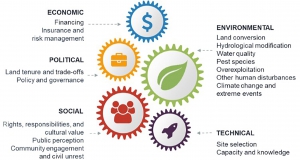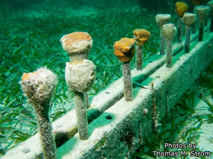The Great Barrier: The Road to Blue Restoration
By Oliver Topel, SRC intern
This blog post covers the scientific paper Blue Restoration–Building Confidence and Overcoming Barriers, written by Phoebe J. Stewart Sinclair et al. The main subject of this paper is a process called “Blue Restoration,” which is the interventions made for the rehabilitation of marine and coastal habitats. Some examples of these are salt marshes, coral reefs, and tidal flats. Until recent years, restoration efforts have been focused more on terrestrial areas, but this focus is slowly shifting to encompass marine areas. For blue restoration to be effective, however, practitioners must overcome five distinct barriers: environmental (land conversion, water quality, human-made issues), technical (site selection and potential capacity), social (public perception and community engagement), economic (financing and insurance), and political (government policies).

Figure 1, image of the five classes of barriers (Source: Sinclair et al. 2020)
While these barriers are difficult to overcome, doing so could lead to exponential improvement in marine and coastal habitats. If blue restoration is successful, it would not only lead to great improvements to biodiversity, but could even mitigate anthropogenic climate change.
In order to expand upon these barriers, the research paper examines four restoration efforts, two of which taking place in Sulawesi, Indonesia, with the other two based in Chesapeake Bay, United States. The four restoration sites illustrate barriers, how to work around them, and how to solve issues. One of these was a coral reef in Sulawesi, Indonesia. Storms, coral mining, and other disturbances caused a coral rubble field, displaying a technical barrier (Williams et al., 2019). The project solved this by deploying structures known as ‘spiders’ (see picture below) to stabilize the rubble and support transplanted coral. After two years, live coral cover went from less than 10% to greater than 60%.

Figure 2, image of ‘spider’ structures, Source: Frontiers in Marine Science
The second of these took place in a shellfish ecosystem in Chesapeake Bay, United States, where oyster restoration was at the center of this project. The eastern oyster (see image below) provides food, water filtration, and more to the local ecosystem and to fisheries. However, due to overfishing and disease, oyster populations have dropped to less than 10% of the average (Wilberg et al., 2011). This being a political barrier, increasing the eastern oyster’s numbers has been a collaboration across several jurisdictions. These efforts are believed to restore the populations of both finfish and shellfish by 2025 (Chesapeake Bay Program, 2019).

Figure 3, image of eastern oysters, Source: NOAA Fisheries
With these projects and many more throughout the world, conservationists and marine affairs workers are putting significant time and effort into the blue restoration. Understanding the five classes of barriers is essential in assuring success of the blue restoration, because even if one barrier is overcome, another can easily undo the headway made. Spreading the information about the successes of these projects is very important, allowing to inspire and educate people on the importance of the blue restoration and all the good it can do for the Earth.
Works cited
Stewart-Sinclair, P. J., Purandare, J., Bayraktarov, E., Waltham, N., Reeves, S., Statton, J., … & Lovelock, C. E. (2020). Blue Restoration–Building Confidence and Overcoming Barriers. Frontiers in Marine Science, 7, 748.
Williams, S. L., Sur, C., Janetski, N., and Hollarsmith, J. (2019). Large-scale coral reef rehabilitation after blast fishing in indonesia: coral reef rehabilitation. Restor. Ecol. 27, 447–456. doi: 10.1111/rec.12866
Wilberg, M. J., Livings, M. E., Barkman, J. S., and Morris, B. T. (2011). Overfishing, disease, habitat loss, and potential extirpation of oysters in upper Chesapeake Bay. Mar. Ecol. Prog. Ser. 436, 131–144. doi: 10.3354/meps09161
Chesapeake Bay Program (2019). Chesapeake Progress. Available online at: https://www.chesapeakeprogress.com

